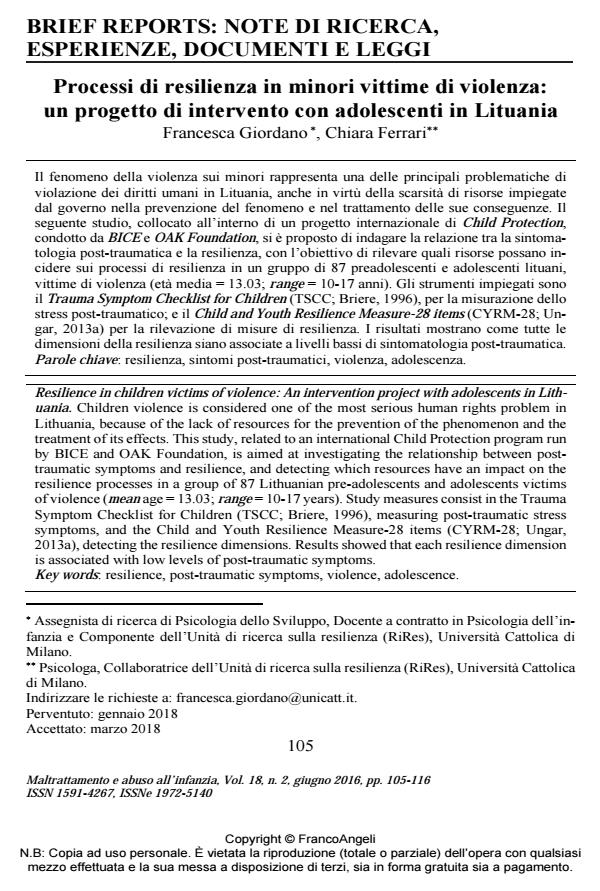Resilience in children victims of violence: An intervention project with adolescents in Lithuania.
Journal title MALTRATTAMENTO E ABUSO ALL’INFANZIA
Author/s Francesca Giordano, Chiara Ferrari
Publishing Year 2018 Issue 2018/2
Language Italian Pages 12 P. 105-116 File size 197 KB
DOI 10.3280/MAL2018-002007
DOI is like a bar code for intellectual property: to have more infomation
click here
Below, you can see the article first page
If you want to buy this article in PDF format, you can do it, following the instructions to buy download credits

FrancoAngeli is member of Publishers International Linking Association, Inc (PILA), a not-for-profit association which run the CrossRef service enabling links to and from online scholarly content.
Children violence is considered one of the most serious human rights problem in Lithuania, because of the lack of resources for the prevention of the phenomenon and the treatment of its effects. This study, related to an international Child Protection program run by BICE and OAK Foundation, is aimed at investigating the relationship between posttraumatic symptoms and resilience, and detecting which resources have an impact on the resilience processes in a group of 87 Lithuanian pre-adolescents and adolescents victims of violence (mean age = 13.03; range = 10-17 years). Study measures consist in the Trauma Symptom Checklist for Children (TSCC; Briere, 1996), measuring post-traumatic stress symptoms, and the Child and Youth Resilience Measure-28 items (CYRM-28; Ungar, 2013a), detecting the resilience dimensions. Results showed that each resilience dimension is associated with low levels of post-traumatic symptoms.
Keywords: Resilience, post-traumatic symptoms, violence, adolescence.
- Running Away from the War in Ukraine: The Impact on Mental Health of Internally Displaced Persons (IDPs) and Refugees in Transit in Poland Damiano Rizzi, Giulia Ciuffo, Giulia Sandoli, Matteo Mangiagalli, Pietro de Angelis, Gioele Scavuzzo, Mariana Nych, Marta Landoni, Chiara Ionio, in International Journal of Environmental Research and Public Health /2022 pp.16439
DOI: 10.3390/ijerph192416439 - Esperienze Sfavorevoli Infantili: un Progetto in Campania per la prevenzione e l'intervento Giulia Savarese, Monica Romei, Luna Carpinelli, Daniela D’Elia, Rosa Angela Villani, Marianna Giordano, Annamaria Scapicchio, Domenico Costantino, in MALTRATTAMENTO E ABUSO ALL'INFANZIA 3/2021 pp.113
DOI: 10.3280/MAL2020-003009 - Child Psychological Adjustment to War and Displacement: A Discriminant Analysis of Resilience and Trauma in Syrian Refugee Children Guido Veronese, Alessandro Pepe, Francesca Giordano, in Journal of Child and Family Studies /2021 pp.2575
DOI: 10.1007/s10826-021-02067-2 - Resilience processes among Ukrainian youth preparing to build resilience with peers during the Ukraine-Russia war Francesca Giordano, Shannon Lipscomb, Philip Jefferies, Kyong-Ah Kwon, Marianna Giammarchi, in Frontiers in Psychology 1331886/2024
DOI: 10.3389/fpsyg.2024.1331886 - Tutor of Resilience: A Model for Psychosocial Care Following Experiences of Adversity Francesca Giordano, Alessandra Cipolla, Michael Ungar, in Frontiers in Psychiatry 559154/2021
DOI: 10.3389/fpsyt.2021.559154 - Building a coordinated response to prevent and respond to Adverse Childhood Experiences (ACEs) in Europe: The Tutor of Resilience program Francesca Giordano, Alessandra Cipolla, in MALTRATTAMENTO E ABUSO ALL'INFANZIA 1/2023 pp.33
DOI: 10.3280/MAL2023-001004 - Transit Migration and Trauma: the Detrimental Effect of Interpersonal Trauma on Syrian Children in Transit in Italy Francesca Giordano, Alessandra Cipolla, Fausto Ragnoli, Federico Brajda Bruno, in Psychological Injury and Law /2019 pp.76
DOI: 10.1007/s12207-019-09345-x - Testing Assisted Resilience Approach Therapy (ARAT) with children victims of violence F. Giordano, F. Ragnoli, F. Brajda Bruno, D. Boerchi, in Children and Youth Services Review /2019 pp.286
DOI: 10.1016/j.childyouth.2018.11.050 - Social-Ecological Resilience Moderates the Effectiveness of Avoidant Coping in Children Exposed to Adversity: An Exploratory Study in Lithuania Francesca Giordano, Simona C. S. Caravita, Philip Jefferies, in Frontiers in Psychology 536353/2020
DOI: 10.3389/fpsyg.2020.536353 - Data on resilience and trauma-related symptoms in Lithuanian children victims of violence F. Giordano, F. Ragnoli, F. Brajda Bruno, in Data in Brief 103791/2019 pp.103791
DOI: 10.1016/j.dib.2019.103791 - Principle-driven program design versus manualized programming in humanitarian settings F. Giordano, M. Ungar, in Child Abuse & Neglect 104862/2021 pp.104862
DOI: 10.1016/j.chiabu.2020.104862 - Building resilience for healthcare professionals working in an Italian red zone during the COVID‐19 outbreak: A pilot study Francesca Giordano, Alessandra Cipolla, Michael Ungar, in Stress and Health /2022 pp.234
DOI: 10.1002/smi.3085 - The Tutor of Resilience Program with Children Who Have Experienced Maltreatment: Mothers’ Involvement Matters F. Giordano, C. Taurelli Salimbeni, P. Jefferies, in Child Psychiatry & Human Development /2024 pp.295
DOI: 10.1007/s10578-022-01393-w
Francesca Giordano, Chiara Ferrari, Processi di resilienza in minori vittime di violenza: un progetto di intervento con adolescenti in Lituania in "MALTRATTAMENTO E ABUSO ALL’INFANZIA" 2/2018, pp 105-116, DOI: 10.3280/MAL2018-002007